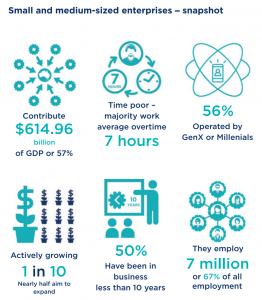
Why Just Talking About SME Issues Won’t Fix Them – We Need Action
The Australian Business Growth Fund (ABGF) and Australian Business Security Fund (ABSF) shouldn’t be needed at all – but they are. The reality is, Australian SME’s are struggling to realise their potential because they lack the capital that they need.
The ABGF and ABSF are not the panaceas that will solve all of the inhibitors to growth that SMEs experience in Australia. Other issues abound, including red tape, inflexible industrial relations systems, internally inadequate systems and lack of entrepreneurial talent.
We have heard both major political parties recently highlight many of these issues, and most of these issues were beautifully canvassed by the Australian Small Business and Family Enterprise Ombudsman, Kate Carnell in the Affordable Capital for SME Growth report.
The formation of the ABSF and the election promise of ABGF are a step in the right direction. Both funds, once they’re up and operating, will provide additional competition and funds for Australian SMEs.
How Important are SMEs?
Despite what many think, big business doesn’t drive Australia’s economy. SMEs do!
P6 of the Affordable Capital for SME Growth report.
Just focus on two numbers. SMEs (organisations with less than 200 people) contribute 57% of Australia’s GDP and employ 67% of the Australian workforce.
Just think about the additional jobs and economic resiliency that a growing, vibrant SME sector delivers.
Is there a need for better access to capital for SMEs?
A resounding YES. SMEs struggle to get debt funding where they don’t have access to real estate as collateral. This is partly due to the criteria imposed by the major lenders in Australia (where the big four banks have more than 80% of the small business lending market), and part of the reason for this is the capital adequacy regulations imposed by government regulators.
Similarly, there is not a market that actively matches the supply of capital with the demand for capital by SMEs (in particular at the smaller end of SMEs). In short, patient and non-controlling capital that backs owners to drive the business forward is hard to come by in Australia.
Does the ABSF And ABGF resolve all of the above issues? Definitely not. But it is one area where government intervention might have the impact of actually creating competition for supply that benefits users (i.e. businesses).
Current Status of ABSF And ABGF?
The ABSF received Royal Assent on 5th April 2019 and is authorised to take investments from 1 July 2019. They are actively recruiting a team to process the expected influx of applications.
The ABGF was a Liberal Party one hundred-million-dollar election promise. We now must wait to see how that promise will be delivered.
We understand that the ABGF would invest in businesses that are not in a startup phase, i.e. those with a proven business model with significant expansion options (both locally and overseas). Equity investments would range from 3 to 20 million dollars for minority stakes. This is the model that has seen the UK BGF invest more than two and a half billion pounds in UK businesses.
“The Australian Business Securitisation Fund (ABSF) will invest up to $2 billion in warehousing and the securitisation market, providing significant additional funding to smaller banks and non-bank lenders to on-lend to small businesses on more competitive terms. It will be administered by the Australian Office of Financial Management (AOFM).”
Why are we interested in ABGF and ABSF?
Both the ABGF and ABSF work in the same space that Second Squared does. We work with talented entrepreneurs to find SME businesses that they can acquire and grow. One of the problems that these talented entrepreneurs will face is finding the necessary capital and finance to deliver on the opportunities.
In particular, we hope that both the ABGF and ABSF follow the US Small Business Association model that allows funding for the acquisition of businesses.
In Australia, like many parts of the world, many of the privately-owned SME’s are owned and operated by baby boomers, and many of these businesses don’t have a transition or succession plan. It is critically important for both Australian growth and overall employment that these businesses transition to new owners in a managed way. Granting access to capital to talented entrepreneurs to find and acquire these businesses is one part of a complex puzzle.
The ABGF and ABSF could be an enabler for Australian growth, and more needs to be done to support Australia SME’s.












